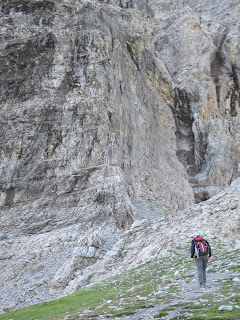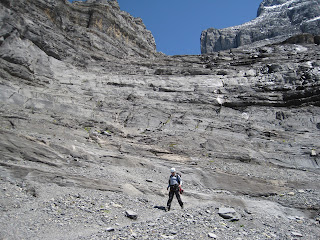I met John and Kara (17) at the Whitney Portal campground to begin our Father/Daughter climb of the East Face of Mt. Whitney. After a hearty dinner at the Portal Store we turned in for the night, but not before we had a bear traipse right through camp. The next morning found us enjoying a grand breakfast at the Portal Store. After stuffing ourselves we packed up and hiked up to camp above Upper Boyscout Lake. The approach hike for the East Face includes amazing views, scrambling, berry eating, and roughly 3000 feet of gain. After setting up camp Kara showed off her new cooking skills she learned on her summer NOLS course. We hit the sack early for out planned 3am start. The morning came quickly and with the light of the crescent moon we launched from camp at 4am. Most of the approach to the base of the climb was done in the dark and we found ourselves racking up just as the alpenglow hit the rock. We started rock climbing around 6am and thirteen pitches later found ourselves on the summit. After some snacks and a register singing we descended the Mountaineers Route back to camp. Day three had a leisurely 6am start, a tasty breakfast, and an enjoyable descent back to the cars. The East Face is truly a classic climb and being able to share it with John and Kara was awesome. Great job team!
 |
| Dinner at the Portal Store |
 |
| Breakfast the next morning, watch out for the pancakes! |
 |
| John, me (Neil), and Kara at the start of the approach. |
 |
| Still lot's of water. |
 |
| The Ledges. |
 |
| Kara and John with Whitney in the background. |
 |
| Kara demonstrating her superior backcountry cooking skills. |
 |
| Alpine start: 4am |
 |
| The sun starting to rise. |
 |
| John and Kara in alpinglow as we rack up. |
 |
| The Tower Traverse. |
 |
| Kara is all smiles after the Fresh Air Traverse. |
 |
| Kara and John at the bottom of the Grand Staircase. |
 |
| Top of the Grand Staircase. |
 |
| Kara on the ridge close to the summit. |
 |
| Summit! 14,497 |
 |
| Descending the Mountaineers Route. |
 |
| Back to camp. |
 |
| Checking the packs to see how much weight we lost. |
 | ||
| Full Circle. |

















































